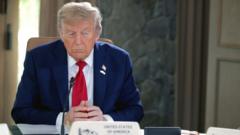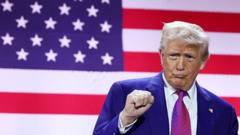On April 10, 2025, President Trump's announcement to pause punitive tariffs on various countries led to significant stock market gains in Asia and Europe. However, tensions between the U.S. and China intensified, especially with China's retaliatory tariffs now in place. Economists remain cautious about the long-term effects on inflation and economic growth.
Global Markets Rally as Trump Suspends Tariffs Amid Escalating Trade Tension

Global Markets Rally as Trump Suspends Tariffs Amid Escalating Trade Tension
Financial markets in Asia and Europe rebound following President Trump's pause on new tariffs, but experts warn of the ongoing impacts of the U.S.-China trade war.
In a surprising pivot during a volatile week for global markets, President Trump announced a 90-day pause on punitive tariffs that previously threatened dozens of nations, leading to a substantial uptick in stock prices across Asian and European markets. After an unprecedented surge in the S&P 500, which marked its biggest gain since 2008, Asian markets, including Taiwan and Japan, saw rises exceeding 9 percent. Meanwhile, the Stoxx Europe 600 index rose by more than 5 percent.
Despite this temporary relief for many nations, Trump maintained a 10 percent base tariff on virtually all imports and continued to impose severe tariffs on China—raising them to an astonishing 125 percent. Experts are concerned that while some nations may benefit from the tariff suspension, the long-term repercussions of the ongoing U.S.-China trade war will not be fully realized for several weeks.
Thursday brought heightened awareness to inflation concerns as economists prepared for the release of the Consumer Price Index, expected to indicate a slowdown in price increases for March. The anticipated results predicted a 2.5 percent rise from the previous year—an increase which, experts warned, came before the bulk of Trump's tariffs were enacted.
Further complicating matters, China's government implemented new tariffs on U.S. imports that surged to 84 percent, leading to fears of broader economic implications. Trump hinted at ongoing negotiations with China's President Xi Jinping but indicated firmly that the U.S. tariff plan would remain stringent, especially against perceived unfair trades.
In a broader scope, the European Union announced a delay on retaliatory tariffs against U.S. imports to allow for an opening for negotiations, while businesses globally were caught in the crossfire, with manufacturers scrambling to mitigate the financial impacts resulting from tariff-induced supply chain disruptions.
As markets reacted to Trump's unexpected tariff suspension, investors remained cautious and alert for indications of future policy shifts, emphasizing a precarious balance between immediate recovery and ongoing trade uncertainty. Analysts point to a potential taxation surge in consumer goods as the complexities of this evolving trade landscape unfold.
In the backdrop of these developments, the economic ramifications persist, with fears looming over higher consumer prices across various sectors, from automobiles to essential goods. While the market showed signs of relief, the long-term health of the U.S. and global economies remained a critical focal point as conversations around trade and tariffs continue to shape business and financial strategies worldwide.
Despite this temporary relief for many nations, Trump maintained a 10 percent base tariff on virtually all imports and continued to impose severe tariffs on China—raising them to an astonishing 125 percent. Experts are concerned that while some nations may benefit from the tariff suspension, the long-term repercussions of the ongoing U.S.-China trade war will not be fully realized for several weeks.
Thursday brought heightened awareness to inflation concerns as economists prepared for the release of the Consumer Price Index, expected to indicate a slowdown in price increases for March. The anticipated results predicted a 2.5 percent rise from the previous year—an increase which, experts warned, came before the bulk of Trump's tariffs were enacted.
Further complicating matters, China's government implemented new tariffs on U.S. imports that surged to 84 percent, leading to fears of broader economic implications. Trump hinted at ongoing negotiations with China's President Xi Jinping but indicated firmly that the U.S. tariff plan would remain stringent, especially against perceived unfair trades.
In a broader scope, the European Union announced a delay on retaliatory tariffs against U.S. imports to allow for an opening for negotiations, while businesses globally were caught in the crossfire, with manufacturers scrambling to mitigate the financial impacts resulting from tariff-induced supply chain disruptions.
As markets reacted to Trump's unexpected tariff suspension, investors remained cautious and alert for indications of future policy shifts, emphasizing a precarious balance between immediate recovery and ongoing trade uncertainty. Analysts point to a potential taxation surge in consumer goods as the complexities of this evolving trade landscape unfold.
In the backdrop of these developments, the economic ramifications persist, with fears looming over higher consumer prices across various sectors, from automobiles to essential goods. While the market showed signs of relief, the long-term health of the U.S. and global economies remained a critical focal point as conversations around trade and tariffs continue to shape business and financial strategies worldwide.





















